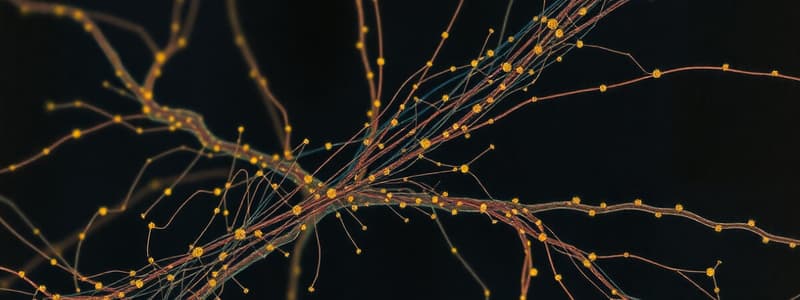Podcast
Questions and Answers
What is the primary role of intermediate filaments in eukaryotic cells?
What is the primary role of intermediate filaments in eukaryotic cells?
- To provide mechanical stability and structural support (correct)
- To form impermeable barriers between cells
- To anchor cells to the extracellular matrix
- To facilitate cell-to-cell communication
Which type of cell junction primarily creates an impermeable barrier between adjacent cells?
Which type of cell junction primarily creates an impermeable barrier between adjacent cells?
- Occluding junctions (correct)
- Anchoring junctions
- Macula junctions
- Zonula junctions
Which type of intermediate filament is specifically found in striated and smooth muscle cells?
Which type of intermediate filament is specifically found in striated and smooth muscle cells?
- Neurofilaments
- Desmin (correct)
- Keratins
- Vimentin
How do anchoring junctions contribute to tissue integrity?
How do anchoring junctions contribute to tissue integrity?
Which of the following is NOT a recognized type of intermediate filament?
Which of the following is NOT a recognized type of intermediate filament?
What best describes the primary function of tight junctions?
What best describes the primary function of tight junctions?
Which protein is crucial for the formation of gap junctions?
Which protein is crucial for the formation of gap junctions?
What is the role of cadherins in zonula adherens?
What is the role of cadherins in zonula adherens?
Desmosomes are most accurately described as:
Desmosomes are most accurately described as:
What characterizes the extracellular space in zonula adherens?
What characterizes the extracellular space in zonula adherens?
Flashcards
Tight Junctions
Tight Junctions
A cell junction that forms a seal around cells, preventing leakage of substances between them.
Intermediate Filaments
Intermediate Filaments
Rope-like protein structures, bundled into helical arrays, providing mechanical support to cells.
Intermediate Filament Types
Intermediate Filament Types
Different types of intermediate filaments exist, each made of unique proteins specific to different cell types (e.g. keratins in skin, desmin in muscle).
Adherens Junctions
Adherens Junctions
Signup and view all the flashcards
Intercellular Junctions
Intercellular Junctions
Signup and view all the flashcards
Desmosomes
Desmosomes
Signup and view all the flashcards
Gap Junctions
Gap Junctions
Signup and view all the flashcards
Occluding Junctions
Occluding Junctions
Signup and view all the flashcards
Anchoring Junctions
Anchoring Junctions
Signup and view all the flashcards
Connexons
Connexons
Signup and view all the flashcards
Study Notes
Intermediate Filaments
- Intermediate filaments are rope-like structures made of tetramers of rod-like proteins
- These proteins are tightly bundled into helical arrays
- The individual subunits of each tetramer differ depending on the type of intermediate filament
- Examples of intermediate filaments include keratins, desmin, vimentin, glial fibrillary acidic protein, neurofilaments, and nuclear lamins
Cytoskeleton & Intercellular Junctions - Learning Objectives
- Correlate the stable nature of intermediate filaments (IMs) to their supportive role in the cell.
- Discuss the importance of cellular specificity of IMs in tumor diagnosis.
- Deduce how the structure of cell junctions relates to their function.
- Interpret the effects of molecular structure abnormalities on tissue integrity.
Cell Junctions
- Cell junctions are specialized areas of attachment between cells
- They are classified morphologically into three main types:
- Zonula (belt-like) junctions: completely encircle the cell
- Fascia (sheet-like) junctions: form broad areas of contact between cells
- Macula (disc-like) junctions: are like spot welds on the cell surface
- Based on their function, cell junctions include:
- Occluding junctions: form an impermeable barrier, preventing passage across the cell sheath
- Anchoring junctions: provide mechanical stability (zonula and macula adherens)
- Communicating junctions: allow the movement of ions or signaling molecules between cells
- Specific examples of junctions:
- Tight junctions (Zonula occludens): fuse membranes to prevent passage between cells
- Adherens junctions: bind cells together using cadherins and actin
- Desmosomes (Macula adherentes): spot welds linking intermediate filaments of adjacent cells
- Gap junctions (nexus): allow small molecules and ions to pass between cells
Clinical Significance
- Identifying intermediate filament proteins through immunocytochemistry is a method to determine tumor origin for diagnosis and treatment.
- Autoantibodies against desmosomal proteins can cause pemphigus vulgaris, a skin disease characterized by blistering.
Studying That Suits You
Use AI to generate personalized quizzes and flashcards to suit your learning preferences.



